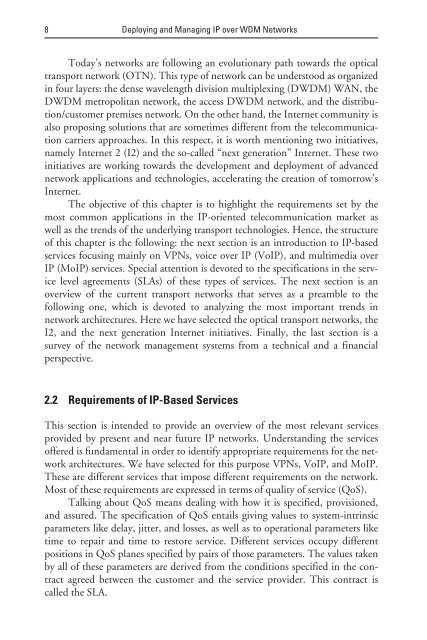deploying and managing ip over wdm networks - Index of
deploying and managing ip over wdm networks - Index of
deploying and managing ip over wdm networks - Index of
You also want an ePaper? Increase the reach of your titles
YUMPU automatically turns print PDFs into web optimized ePapers that Google loves.
8 Deploying <strong>and</strong> Managing IP <strong>over</strong> WDM Networks<br />
Today’s <strong>networks</strong> are following an evolutionary path towards the optical<br />
transport network (OTN). This type <strong>of</strong> network can be understood as organized<br />
in four layers: the dense wavelength division mult<strong>ip</strong>lexing (DWDM) WAN, the<br />
DWDM metropolitan network, the access DWDM network, <strong>and</strong> the distribution/customer<br />
premises network. On the other h<strong>and</strong>, the Internet community is<br />
also proposing solutions that are sometimes different from the telecommunication<br />
carriers approaches. In this respect, it is worth mentioning two initiatives,<br />
namely Internet 2 (I2) <strong>and</strong> the so-called “next generation” Internet. These two<br />
initiatives are working towards the development <strong>and</strong> deployment <strong>of</strong> advanced<br />
network applications <strong>and</strong> technologies, accelerating the creation <strong>of</strong> tomorrow’s<br />
Internet.<br />
The objective <strong>of</strong> this chapter is to highlight the requirements set by the<br />
most common applications in the IP-oriented telecommunication market as<br />
well as the trends <strong>of</strong> the underlying transport technologies. Hence, the structure<br />
<strong>of</strong> this chapter is the following: the next section is an introduction to IP-based<br />
services focusing mainly on VPNs, voice <strong>over</strong> IP (VoIP), <strong>and</strong> multimedia <strong>over</strong><br />
IP (MoIP) services. Special attention is devoted to the specifications in the service<br />
level agreements (SLAs) <strong>of</strong> these types <strong>of</strong> services. The next section is an<br />
<strong>over</strong>view <strong>of</strong> the current transport <strong>networks</strong> that serves as a preamble to the<br />
following one, which is devoted to analyzing the most important trends in<br />
network architectures. Here we have selected the optical transport <strong>networks</strong>, the<br />
I2, <strong>and</strong> the next generation Internet initiatives. Finally, the last section is a<br />
survey <strong>of</strong> the network management systems from a technical <strong>and</strong> a financial<br />
perspective.<br />
2.2 Requirements <strong>of</strong> IP-Based Services<br />
This section is intended to provide an <strong>over</strong>view <strong>of</strong> the most relevant services<br />
provided by present <strong>and</strong> near future IP <strong>networks</strong>. Underst<strong>and</strong>ing the services<br />
<strong>of</strong>fered is fundamental in order to identify appropriate requirements for the network<br />
architectures. We have selected for this purpose VPNs, VoIP, <strong>and</strong> MoIP.<br />
These are different services that impose different requirements on the network.<br />
Most <strong>of</strong> these requirements are expressed in terms <strong>of</strong> quality <strong>of</strong> service (QoS).<br />
Talking about QoS means dealing with how it is specified, provisioned,<br />
<strong>and</strong> assured. The specification <strong>of</strong> QoS entails giving values to system-intrinsic<br />
parameters like delay, jitter, <strong>and</strong> losses, as well as to operational parameters like<br />
time to repair <strong>and</strong> time to restore service. Different services occupy different<br />
positions in QoS planes specified by pairs <strong>of</strong> those parameters. The values taken<br />
by all <strong>of</strong> these parameters are derived from the conditions specified in the contract<br />
agreed between the customer <strong>and</strong> the service provider. This contract is<br />
called the SLA.


